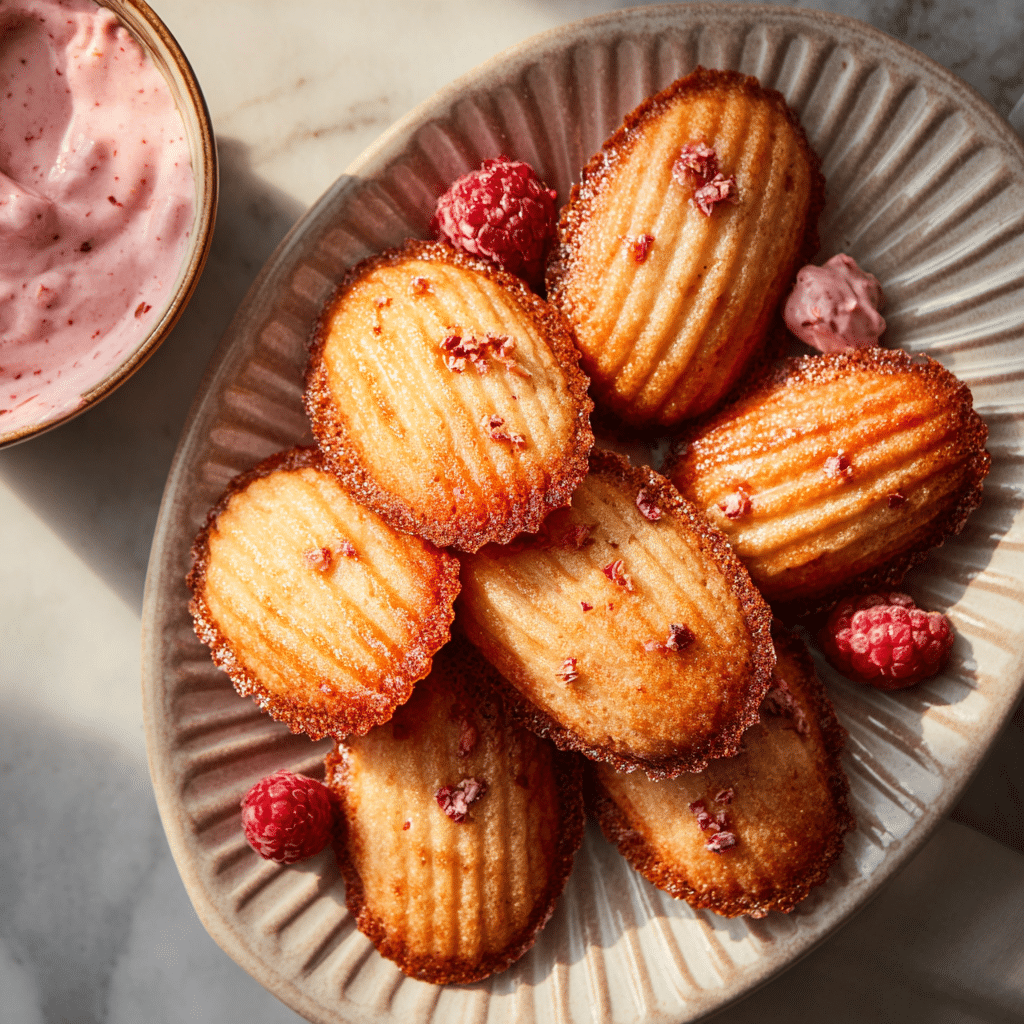These Rose Madeleines are a delightful twist on the classic French pastry. Infused with floral rose water and topped with a delicate glaze, each bite offers a soft, buttery crumb that melts in your mouth. Whether served plain with a dusting of powdered sugar or dressed up with edible rose petals, these little shell-shaped cakes are as beautiful as they are delicious.
Perfect for afternoon tea, bridal showers, or a romantic dessert spread, these madeleines are a treat for the senses. The subtle perfume of rose gives them a unique and sophisticated charm, making them stand out from ordinary bakes. Simple to make and stunning on the plate, they’ll quickly become your go-to for elegant entertaining.
Full Recipe
Ingredients:
-
1/2 cup (113 g) unsalted butter
-
2/3 cup (85 g) all-purpose flour
-
1/2 tsp baking powder
-
1/8 tsp salt
-
2 large eggs
-
1/2 cup (100 g) granulated sugar
-
1 tbsp honey
-
1 tsp rose water
-
1/2 tsp vanilla extract
-
Powdered sugar, for dusting (optional)
Optional Glaze:
-
1/2 cup powdered sugar
-
1–2 tsp rose water
-
1–2 tsp milk or water (to reach desired consistency)
-
Dried edible rose petals (for garnish)
Directions:
-
Melt the butter in a saucepan or microwave, then let it cool to room temperature.
-
In a small bowl, whisk together the flour, baking powder, and salt.
-
In a large bowl, beat the eggs and sugar together using a hand mixer until pale and thick, about 4–5 minutes.
-
Add the honey, rose water, and vanilla extract to the egg mixture and mix until combined.
-
Sift the flour mixture into the wet ingredients and fold gently until just combined.
-
Fold in the melted butter in two additions until the batter is smooth and well incorporated.
-
Cover the bowl and chill in the refrigerator for at least 1 hour, preferably overnight.
-
Preheat the oven to 375°F (190°C). Grease a madeleine pan and lightly flour it.
-
Fill each mold 3/4 full with batter. Bake for 10–12 minutes or until the edges are golden and the centers spring back when touched.
-
Let the madeleines cool for a few minutes before unmolding onto a wire rack.
-
Optional: In a small bowl, mix the powdered sugar with rose water and a little milk to form a glaze. Dip each madeleine halfway and top with rose petals. Let the glaze set.
Prep Time: 15 minutes | Chill Time: 1 hour | Baking Time: 12 minutes | Total Time: 1 hour 27 minutes
Kcal: 110 kcal | Servings: 12 madeleines
The Art of Baking Rose Madeleines
Rose Madeleines represent the beautiful intersection between traditional French patisserie and delicate floral baking. These iconic shell-shaped cakes, traditionally associated with French cafés and teatimes, are elevated here with the sophisticated aroma and taste of rose water. Their soft, buttery texture and subtle fragrance offer an elegant alternative to more common desserts, making them perfect for special occasions or a refined afternoon treat.
A Romantic Twist on a French Classic
The original madeleine, popularized by Marcel Proust’s In Search of Lost Time, is a light sponge cake that’s typically flavored with lemon or vanilla. However, this modern version replaces citrus with rose water—a timeless ingredient in Middle Eastern and Mediterranean cuisines—to create something even more luxurious. The rose water provides a floral elegance that’s both fragrant and light, transforming a humble madeleine into a romantic pastry fit for high tea or festive gatherings.
The Charm of Shell-Shaped Perfection
One of the most distinctive features of madeleines is their signature shell shape, achieved by baking them in specially designed pans. This shape isn’t just about aesthetics—it allows for the perfect ratio of golden crust to fluffy interior. When baked correctly, madeleines also form their characteristic “hump” on the back, a mark of proper technique and temperature control. These visual cues make madeleines not just a treat for the taste buds but also for the eyes—especially when finished with a dusting of powdered sugar or a thin glaze.
Why Rose Water?
Rose water is an ingredient known for its delicate floral essence. It adds a sophisticated layer to desserts, lending aroma more than assertive flavor. In this recipe, it enhances the gentle sweetness of the batter without overpowering it. When paired with vanilla and honey, the rose notes blend harmoniously, evoking the feeling of a spring garden with every bite. For those who appreciate subtlety and nuance in baking, rose water offers a truly unique experience that elevates the dessert beyond the ordinary.
Baking Tips for Perfect Madeleines
Achieving the ideal madeleine texture requires a few key techniques. First, resting the batter is essential. Allowing the batter to chill—preferably overnight—gives the flour time to hydrate and helps develop the structure that forms the classic hump. Additionally, greasing and flouring the madeleine pan ensures easy release and a beautiful finish. Using quality butter and not overmixing the batter also contribute to the light, tender crumb that defines this treat.
Temperature plays a crucial role. A properly preheated oven encourages the rapid rise needed for that dome-like shape. Additionally, avoid opening the oven door too early—moisture and temperature loss can cause the madeleines to collapse.
Customizing the Look and Flavor
One of the joys of this recipe is how customizable it is. You can choose to add a thin glaze using rose water and powdered sugar, which not only adds flavor but also a glossy finish that catches the light beautifully. Sprinkling dried edible rose petals over the glaze introduces texture and an additional visual element. For a more minimalistic look, a simple dusting of powdered sugar is elegant and understated.
For a richer profile, you could incorporate a bit of citrus zest—like lemon or orange—alongside the rose, or even infuse the butter with dried culinary lavender before folding it in. These subtle tweaks allow you to make the recipe your own while keeping the floral sophistication intact.
Pairing and Serving Suggestions
Rose Madeleines are perfect for tea parties, brunch tables, or even as edible gifts. They pair beautifully with lightly brewed teas—especially Earl Grey, chamomile, or rose petal blends. Coffee lovers might enjoy them with a creamy latte or a subtly sweet cappuccino. Because they’re not overly sweet, they serve as a wonderful counterbalance to stronger beverages.
If you’re serving them as part of a dessert spread, they go well with other delicate treats like shortbread cookies, macarons, or lemon tarts. You can even serve them alongside a berry compote or fresh cream for an elevated dessert presentation.
Cultural and Culinary Significance
Madeleines are a celebrated French pastry not only because of their taste but also because of their history. Immortalized in literature and beloved across generations, they carry a sense of nostalgia and elegance. Infusing them with rose water adds a multicultural flair, reflecting global culinary influences and the trend of blending classic European techniques with exotic ingredients.
This recipe also speaks to modern preferences—lighter desserts, floral profiles, and minimalistic presentation. It’s perfect for home bakers looking to create something impressive yet manageable, and it introduces new bakers to the world of refined flavor profiles without the need for complex methods or tools.
Storage and Freshness
Madeleines are best enjoyed fresh, ideally within a day of baking when they’re soft, moist, and fragrant. However, they can be stored in an airtight container for up to 2–3 days. After that, they tend to dry out, though they can still be revived slightly with a few seconds in the microwave. If you’ve glazed them, allow the glaze to set fully before storing to avoid sticking.
You can also freeze madeleines for future enjoyment. Place them in a single layer on a baking sheet to freeze individually before transferring them to a freezer bag. To serve, thaw at room temperature and warm slightly in the oven to restore their texture.
Conclusion: A Treat Worth Savoring
Rose Madeleines are more than just dainty French cakes—they are a sensory experience. From their floral aroma to their tender crumb and elegant shape, they are a reminder of how baking can be both simple and artistic. Whether you’re preparing them for a celebration, a relaxing afternoon tea, or a quiet moment of indulgence, these madeleines deliver beauty and taste in every bite.
Baking them offers a rewarding experience for both seasoned bakers and beginners alike. The process is meditative, the presentation impressive, and the results deeply satisfying. If you’re looking to bring a little more charm and sophistication into your dessert repertoire, Rose Madeleines are a perfect place to start.






